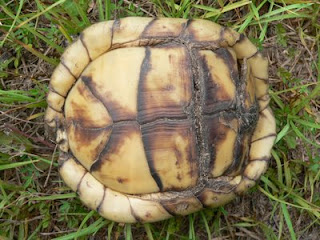Reptilian Speed Bump
 Cruising down a winding country road I detect a small protuberance up ahead on the center stripe and immediately know what I’m seeing- a turtle about to become “street pizza”. Now if you’re like me you’re not going to just pass it by and wish it luck. I’ve saved many a turtle over the years (as well as snakes and frogs) and I wasn’t about to ignore this one. So I pulled over to the shoulder and watched horrified in my rear-view mirror as one-two-three cars sped directly over it. I put on my emergency flashers, checked both ways like my mom taught me, and hurried over to it while getting odd looks from passersby as they blast past me in the opposite lane. Most times it’s a red-eared slider (Trachemys scripta elegans) , mud (Kinosternon subrubrum), or snapping turtle (Chelydra serpentina), but this time it was a beautiful box turtle. Due to habitat loss and fragmentation these turtles (like most other animals) are slowly but surely being squeezed out and put into harm’s way. As I reached down to pick it up, legs and head disappear as it withdraws into the confines of its protective shell. This bony armor works well against predators, but it’s no match against a ton of speeding metal. With its hinged plastron (lower shell) shut as tight as a tick I walk over with it to the edge of the road so I could examine it closer. It might be good to mention here that if you come across one in this same situation always place it on the side of the road that it was headed for. If not, it will turn around and head right back into a death trap.
Cruising down a winding country road I detect a small protuberance up ahead on the center stripe and immediately know what I’m seeing- a turtle about to become “street pizza”. Now if you’re like me you’re not going to just pass it by and wish it luck. I’ve saved many a turtle over the years (as well as snakes and frogs) and I wasn’t about to ignore this one. So I pulled over to the shoulder and watched horrified in my rear-view mirror as one-two-three cars sped directly over it. I put on my emergency flashers, checked both ways like my mom taught me, and hurried over to it while getting odd looks from passersby as they blast past me in the opposite lane. Most times it’s a red-eared slider (Trachemys scripta elegans) , mud (Kinosternon subrubrum), or snapping turtle (Chelydra serpentina), but this time it was a beautiful box turtle. Due to habitat loss and fragmentation these turtles (like most other animals) are slowly but surely being squeezed out and put into harm’s way. As I reached down to pick it up, legs and head disappear as it withdraws into the confines of its protective shell. This bony armor works well against predators, but it’s no match against a ton of speeding metal. With its hinged plastron (lower shell) shut as tight as a tick I walk over with it to the edge of the road so I could examine it closer. It might be good to mention here that if you come across one in this same situation always place it on the side of the road that it was headed for. If not, it will turn around and head right back into a death trap.  Noting the “keel” that ran down the center of its carapace (upper shell) and the fact that its shell was “flared” along its edges told me it was an Eastern box turtle (Terrapene
Noting the “keel” that ran down the center of its carapace (upper shell) and the fact that its shell was “flared” along its edges told me it was an Eastern box turtle (Terrapene There are many people who rescue turtles, in fact there’s a website appropriately tagged “Turtle Crossings” where you can document reports, photographs and even longitude and latitude coordinates (via gps) of where the turtle crossed. Rescuing turtles requires diligence on your part, as your safety trumps that of the turtle. Not paying attention and becoming mesmerized about reaching it in time could result in you getting splattered. There’s another precaution that should be duly noted when rescuing turtles- when you pick them up be sure to direct their hind end away from yourself otherwise you’ll be surprised when you get christened by a thick jet stream of turtle urine. I’ve found this especially true with red-eared sliders. Just there way of saying “thanks”.
Sources:
http://www.enature.com/flashcard/show_flash_card.asp?recordNumber=AR0144
http://en.wikipedia.org/wiki/Eastern_Box_Turtle
http://www.fs.fed.us/database/feis/animals/reptile/teca/all.html
Rose, Francis L. 1986. Carapace regeneration in Terrapene (Chelonia: Testudinidae). The Southwestern Naturalist. 31(1): 131-134. [62090]
Smith, Hobert M. 1958. Total regeneration of the carapace in a box turtle. Turtox News. 36: 234-236. [62091]
Labels: box turtle, eastern box turtle, ornate box turtle, turtle





5 Comments:
There's a chapter in "Grapes of Wrath" about a tortoise crossing a road. Even Steinbeck was aware of the risks.
I stop for reptiles on the road too.
Great post.
I don't know how many I've moved off the road. It's always difficult to decide which side of the road to put them on, and which direction to point them.
Come visit anytime,
Troy
Enjoyed reading your blog. Very nice! Keep up the good work.
Texas Travellers/Codger,
I've always heard to put them on the side of the road in which they were headed. Nice to know others out there are willing to help.
Jace
Steven,
Thanks for the kudos!
Jace
Post a Comment
<< Home